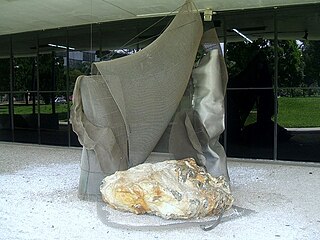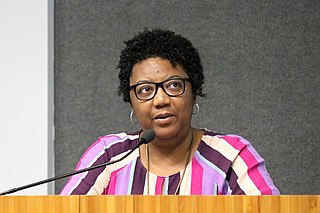Lia Mascarenhas Menna Barreto is a Brazilian studio artist currently based in Rio Grande do Sul.
Brígida Baltar was a Brazilian visual artist. Her work spanned across a wide range of mediums, including video, performance, installation, drawing, and sculpture. She was interested in capturing the ephemeral in her artwork.

Gretta Sarfaty, born Alegre Sarfaty, is also known as Gretta Grzywacz and Greta Sarfaty Marchant, also simply as Gretta. is a painter, photographer and multimedia artist who earned international acclaim in the 1970s, from her artistic works related to Body art and Feminism. Born in Greece, in 1947, she moved with her family to São Paulo in 1954, being naturalized as Brazilian.

The roots of Brazilian sculpture have been traced back to the late 16th century, emerging soon after the first settlements in the newly discovered land. Through the following century, most of the sculpture in Brazil was brought from Portugal and displayed Baroque features. The Baroque style would flourish within the religious culture of the country and would remain predominant until the first decades of the 19th century. In the 19th century, sculptural activity decreased, but it later revived when both the government and the public took a new interest in the art. Modernism fomented a period of intense research into a new language of sculpture, with great achievements, and the contemporary sculpture of Brazil enjoys worldwide respect.

Felícia Leirner (1904–1996) was a Polish-born Brazilian sculptor. She was born in Warsaw and arrived in Brazil in 1927. At the age of 44, she began studying sculpture with the photographer Victor Brecheret. Her early work belonged to the figurative phase (1950–58). She initially created isolated figures. In 1953 and 1955, she participated in the São Paulo Art Biennial. In 1955, she received an award from the Museum of Modern Art, Rio de Janeiro. Her sculptures were incorporated into the collections of the São Paulo Museum of Art and the Musée d'Art Moderne de la Ville de Paris. She died in Campos do Jordão, São Paulo in 1996.

Iole Antunes de Freitas is a Brazilian sculptor, engraver, and installation artist who works in the field of contemporary art. Freitas began her career in the 1970s, participating in a group of artists in Milan, Italy linked to Body art. She used photography. In the 1980s, she returned to Brazil, but abandoned the human body as mediator of her work, adopting the "sculpture body". The artist uses materials such as wire, canvas, steel, copper, stone, and water to create her works.

Sheila Leirner is a French Brazilian curator, journalist, and art critic, as well as a writer. She was chief curator of the XVIII and XIX São Paulo Art Biennials.
Antonio José de Barros Carvalho e Mello Mourão, known professionally as Tunga, was a Brazilian sculptor and performance artist. Tunga was born in Palmares, Pernambuco, Brazil.
Waldemar Cordeiro was an Italian-born Brazilian art critic and artist. He worked as a computer artist in the early days of computer art and was a pioneer of the concrete art movement in Latin America.
Judith Lauand was a Brazilian painter and printmaker. She is considered a pioneer of the Brazilian modernist movement that started in the 1950s, and was the only female member of the concrete art movement based in São Paulo, the Grupo Ruptura.
Hermelindo Fiaminghi was a Brazilian painter, designer, graphic designer, lithographer, professor, and art critic, known for his geometric works and exploration of color.
Tatiana Blass is a Brazilian artist that constructs complex abstract narratives with her performances, paintings, videos, and installations.

Elisa Bracher is a Brazilian artist, mostly known for her wooden and stone monumental sculptures, as well as drawings and prints with organic or geometric features.
Valeska Soares is a Brooklyn-based Brazilian-American sculptor and installation artist.
Marcia Grostein Marcia Grostein is a Brazilian-American artist known for using various mediums across public art, sculpture, painting, video art, photography, and portable wearable art/jewelry. She was the first contemporary Brazilian artist to be acquired by the Metropolitan Museum of Art for the 20th Century Collection by the curator Lowery Sims.

Yolanda Léderer Mohalyi was a painter and designer who worked with woodcuts, mosaics, stained glass and murals as well as more usual materials. Her early work was figurative, but she increasingly moved towards abstract expressionism. With artists such as Waldemar da Costa and Cicero Dias, she opened the way for abstraction in Latin American art.

Rosana Paulino is a Brazilian contemporary artist, curator, and researcher. Paulino holds a doctorate in Visual Arts from the University of São Paulo, School of Communications and Arts and a specialization in printmaking from London Print Studio. She was awarded the Mercosur Konex Award from Argentina in 2022. Paulino engages with mediums including drawing, embroidery, engraving, printmaking, collage, and sculpture, often to engage with archetypes, memory, familial legacies, histories of racial violence and slavery in Brazil and to explore, what she describes as, Black female psychology. Her works have been displayed in several shows in the UK, France, Belgium, Italy, Spain, Portugal, Cape Verde, Puerto Rico, USA, Mexico, and Brazil. She has had solo exhibitions in Belgium, Germany, and Brazil.
Galeria Luisa Strina is an art gallery founded by art collector Luisa Malzone Strina. The main gallery and its annex are located in São Paulo, Brasil. It is the oldest art gallery of contemporary art in Brazil.
Luisa Malzone Strina is a Brazilian art gallerist and art collector. Her gallery, Galeria Luisa Strina, is the oldest contemporary art gallery in Brazil.

Carmela Gross or Maria do Carmo da Costa Gross is a Brazilian visual artist and educator. She is noted for her avant-garde productions on visual arts that focus on pop art, visual vocabulary of children, architecture and the urban landscape.









